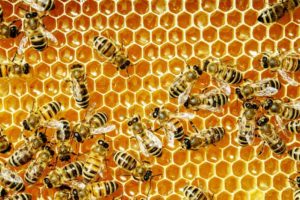
The cataclysmic events that wiped out the land dinosaurs some 65 million years ago took a toll on smaller creatures too, causing widespread extinction in bees, Flinders University research has found.
In a world first, research by biological scientists Associate Professor Mike Schwarz, Dr Sandra Rehan and Dr Remko Leys has shown that the events at the so-called K-T boundary caused massive extinctions among bee populations, reflected in major changes in the development of flowering plants on Earth.
The findings are the subject of a newly published paper in the academic journal PLOS ONE.
Unlike dinosaurs, which left a legacy of large and frequent fossil deposits, mapping the effect of such an event on bees has always been problematic: “Bees fossilise very poorly, and their presence in the fossil record is very patchy,” Associate Professor Schwarz said.
There is a concentration of fossilised bees in amber from 45 million years ago, but earlier bees are scarcely represented in the record at all. The fossil record does, however, indicate disruption in the evolution of flowering plants consistent with the K-T event.
Unable to rely on fossil evidence for bees, Associate Professor Schwarz’s team turned to a technique known as molecular phylogenetic analysis that extracts fragments of bee genes and, in effect, enables scientists to track paths of genetic development retrospectively.
The Flinders-based team used 230 bee species from one subfamily, taken from every continent (except Antarctica). The four tribes within the subfamily have a wide variety of geographic adaptation and nesting behaviour, thus providing a broad and viable sample for the research.
The analysis of the bees’ lineage showed a pattern of early diversification followed by a long period during which development effectively stalled; this was then followed by further rapid diversification in all four tribes.
“When we find that something is affecting all of them in the same way, you have to ask what that would be,” Associate Professor Schwarz said.
“What we found was a genetic signature that is exactly what you would expect for a massive extinction event, and it corresponds very closely in time with the extinction of the dinosaurs.”
Because bees are the main pollinators of flowering plants and their evolution is closely linked, Associate Professor Schwarz said the implications of extinction of bee populations are profound, and would have had major consequences for flowering plants as well as the subsequent evolution of bees themselves.
The complete paper can be accessed via this web link: http://dx.plos.org/10.1371/journal.pone.0076683

